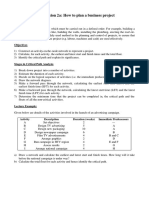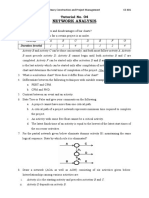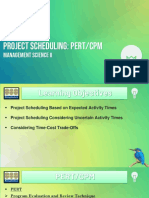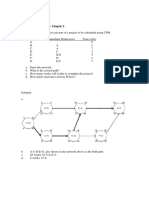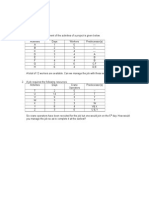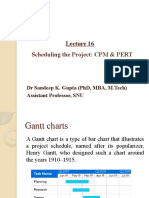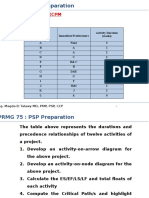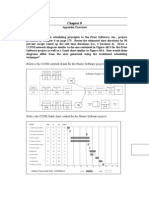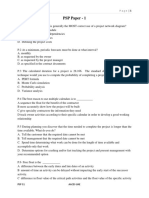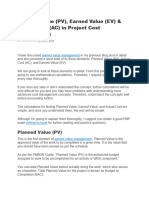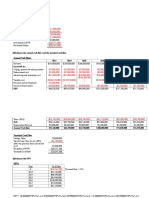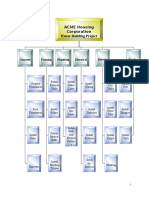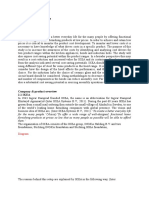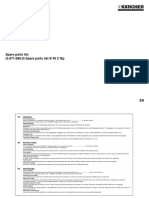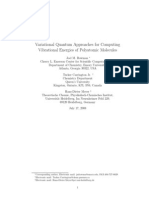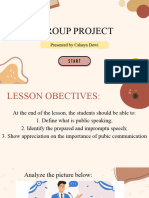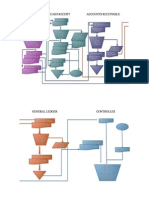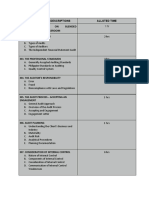Project Scheduling: Lagging,
Crashing, and Activity
Networks
10-01
�Chapter 10 Learning Objectives
After completing this chapter, students will be able to:
Apply lag relationships to project activities.
Construct and comprehend Gantt charts.
Recognize alternative means to accelerate projects,
including their benefits and drawbacks.
Understand the trade-offs required in the decision to crash
project activities.
Develop activity networks using Activity-on-Arrow
techniques.
Understand the differences in AON and AOA and
recognize the advantages and disadvantages of each
technique.
Copyright 2013 Pearson Education
10-02
�Lags in Precedence Relationships
The logical relationship between the start and
finish of one activity and the start and finish of
another activity.
Four logical relationships between tasks
1. Finish to Start
2. Finish to Finish
3. Start to Start
4. Start to Finish
Copyright 2013 Pearson Education
10-03
�Finish to Start Lag
Most common type of sequencing
Shown on the line joining the modes
Added during forward pass
Subtracted during backward pass
0
A
6
Spec Design
6
Copyright 2013 Pearson Education
6
B
11
Design Check
5
Lag 4
15
C
22
Blueprinting
7
10-04
�Finish to Finish Lag
Two activities share a similar completion point
The mechanical inspection cannot happen until wiring,
plumbing, and HVAC installation are complete
15
D
Wiring
6
21
10
A
16
Plumbing
6
Lag 3
Copyright 2013 Pearson Education
16
B
HVAC
5
21
21
C
22
Inspection
1
10-05
�Start to Start Lag
30
D
Wiring
6
36
Lag 3
31
A
33
Plumbing
6
Copyright 2013 Pearson Education
33
B
HVAC
5
36
36
C
37
Inspection
1
10-06
�Start to Finish Lag
Least common type of lag relationship
Successors finish dependent on
predecessors start
30
D
Wiring
6
36
22
A
28
Plumbing
6
Copyright 2013 Pearson Education
Lag 3
28
B
HVAC
5
33
33
C
34
Inspection
1
10-07
�Gantt Charts
Establish a time-phased network
Can be used as a tracking tool
Benefits of Gantt charts
1. Easy to create and comprehend
2. Identify the schedule baseline network
3. Allow for updating and control
4. Identify resource needs
Copyright 2013 Pearson Education
10-08
�Completed Gantt Chart for Project Delta
FIGURE 10.8
Copyright 2013 Pearson Education
10-9
�Gantt Chart for Project Delta with
Critical Path Highlighted
FIGURE 10.9
Copyright 2013 Pearson Education
10-10
�Gantt Chart with Resources Specified
FIGURE 10.10
Copyright 2013 Pearson Education
10-11
�Gantt Chart with Lag Relationships
FIGURE 10.11
Copyright 2013 Pearson Education
10-12
�Crashing
The process of accelerating a project
Principal methods for crashing
Improving existing resources productivity
Changing work methods
Compromise quality and/or reduce project scope
Institute fast-tracking
Work overtime
Increasing the quantity of resources
Copyright 2013 Pearson Education
10-13
�Managerial Considerations
Determine activity fixed and variable costs
The crash point is the fully expedited activity
Optimize time-cost tradeoffs
Shorten activities on the critical path
Cease crashing when
the target completion time is reached
the crashing cost exceeds the penalty cost
Copyright 2013 Pearson Education
10-14
�Project Activities and Costs
Normal
Crashed
Activity
Duration
5 days
$ 1,000
3 days
$ 1,500
7 days
700
6 days
1,000
3 days
2,500
2 days
4,000
5 days
1,500
5 days
1,500
9 days
3,750
6 days
9,000
4 days
1,600
3 days
2,500
6 days
2,400
4 days
3,000
8 days
9,000
5 days
15,000
Total costs
Copyright 2013 Pearson Education
Cost
$22,450
Duration
Cost
$37,500
Table 10.1
10-15
�FIGURE 10.14 TimeCost Trade-Offs for Crashing Activities
Copyright 2013 Pearson Education
10-16
�FIGURE 10.15 Fully Crashed Project Activity Network
Copyright 2013 Pearson Education
10-17
�FIGURE 10.16 Relationship Between Cost and Days Saved in a Crashed Project
Copyright 2013 Pearson Education
10-18
�Activity on Arrow Networks
Activities represented by arrows
Widely used in construction
Event nodes easy to flag
Forward and backward pass logic similar to AON
Two activities may not begin and end at common
nodes
Dummy activities may be required
Copyright 2013 Pearson Education
10-19
�Notation for Activity-on-Arrow (AOA)
Networks
FIGURE 10.18
Copyright 2013 Pearson Education
10-20
�Sample Network Diagram Using AOA
Approach
FIGURE 10.19
Copyright 2013 Pearson Education
10-21
�Representing Activities with Two or More
Immediate Successors(Wrong)
FIGURE 10.20A
Copyright 2013 Pearson Education
10-22
�Alternative Way to Represent Activities
with Two or More Immediate Successors
(Wrong)
FIGURE 10.20B
Copyright 2013 Pearson Education
10-23
�Representing Activities with Two or More
Immediate Successors Using Dummy
Activities (Better)
FIGURE 10.20C
Copyright 2013 Pearson Education
10-24
�Partial Project Delta Network Using AOA
Notation
FIGURE 10.21
Copyright 2013 Pearson Education
10-25
�Completed Project Delta AOA Network
FIGURE 10.22
Copyright 2013 Pearson Education
10-26
�Project Delta Forward Pass Using AOA
Network
FIGURE 10.23
Copyright 2013 Pearson Education
10-27
�Project Delta Backward Pass Using AOA
Network
FIGURE 10.24
Copyright 2013 Pearson Education
10-28
�Controversies in the Use of Networks
Networks can be too complex
Poor network construction creates problems
Networks may be used inappropriately
When employing subcontractors
The master network must be available to them
All sub-networks must use common methods
Positive bias exists in PERT networks
Copyright 2013 Pearson Education
10-29
�Summary
1.
2.
3.
4.
5.
6.
Apply lag relationships to project activities.
Construct and comprehend Gantt charts.
Recognize alternative means to accelerate projects,
including their benefits and drawbacks.
Understand the trade-offs required in the decision to
crash project activities.
Develop activity networks using Activity-on-Arrow
techniques.
Understand the differences in AON and AOA and
recognize the advantages and disadvantages of each
technique.
Copyright 2013 Pearson Education
10-30
�Crashing Example 1
�Crashing Example 1
Cost per time period is =
Crash cost- Normal cost
Normal time-crash time
Copyright 2013 Pearson Education
�Crashing Example 1
Activity A$ 6,000 per week
Activity B$10,000 per week
Activity C$ 5,000 per week
Activity D$ 6,000 per week
Normal Project Duration is 18 weeks
Normal Project Costs is $ 200,000
Copyright 2013 Pearson Education
�Crashing Example 1
Reduce Project duration to 17 weeks
Critical path ?
Lowest costs ?
Outcome
Project Duration = 17 weeks
Project Costs = $ 205,000
Copyright 2013 Pearson Education
�Crashing Example 1
Reduce Project duration to 16 weeks
Critical path ?
Lowest costs ?
Outcome
Project Duration = 16 weeks
Project Costs = $ 211,000
Copyright 2013 Pearson Education
�Crashing Example 1
Reduce Project duration to 15 weeks
Critical path ?
Lowest costs ?
Outcome
Project Duration = 15 weeks
Project Costs = $ 223,000
Copyright 2013 Pearson Education
�Crashing Example 2
Calculate the minimum extra costs if the project is to be speeded up to 12 weeks
B
8
13
13
11
13
13
13
13
E
5
18
18
laluan kritikal
Rajah : Rangkaian dengan jangkamasa normal
Copyright 2013 Pearson Education
8-37
�Crashing Example 2
Jadual 5
Aktiviti
A
B
C
D
E
Normal
Duration
5
8
6
4
5
Normal
Cost ($)
2000
2500
3000
2000
1000
Crash
Duration
3
2
4
4
3
Crash
Cost ($)
2400
4500
4500
2000
3500
Rate
$/week
200
333
750
1250
Mix
compression
(weeks)
2
6
2
2
Rate ($/week) = crash cost - normal cost
normal time-crash time
Copyright 2013 Pearson Education
8-38
�Crashing Example 2
Ist compression
(crash A 1 minggu)
4
B
8
12
12
10
12
17
12
12
17
11
Copyright 2013 Pearson Education
laluan kritikal
12
8-39
�Crashing Example 2
(crash A 1 minggu)
3
B
8
11
11
11
D
7
Copyright 2013 Pearson Education
7
4
11
11
16
16
laluan kritikal
11
8-40
�Crashing Example 2
2nd compression
(crash B-1 minggu)
3
B
7
10
10
10
10
10
10
Copyright 2013 Pearson Education
E
5
15
15
laluan kritikal
8-41
�Crashing Example 2
(crash B-1 minggu)
B
6
9
9
14
14
Copyright 2013 Pearson Education
laluan kritikal
8-42
�Crashing Example 2
3rd compression
(crash B-1 minggu dan C-1 minggu)
B
5
Copyright 2013 Pearson Education
E
5
13
13
laluan kritikal
8-43
�Crashing Example 2
(crash B-1 minggu dan C-1 minggu)
3
B
4
7
7
Copyright 2013 Pearson Education
E
5
12
12
laluan kritikal
8-44
�Crashing Example 2
Jadual 6
Pendekkan A
Pendekkan B
Pendekkan B, C
Jumlah
Jumlah kos ($)
Masa dijimat
(minggu)
Kos
tambahan/minggu
Duration
(minggu)
400
666
2166
3232
2
2
2
200
333
1083
16
14
12
Copyright 2013 Pearson Education
8-45


